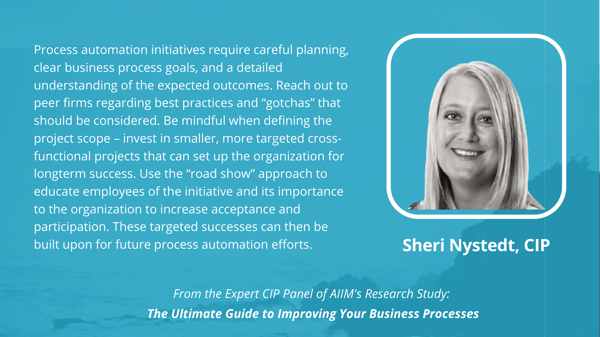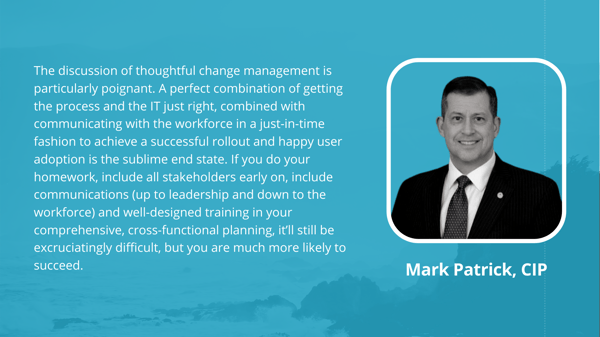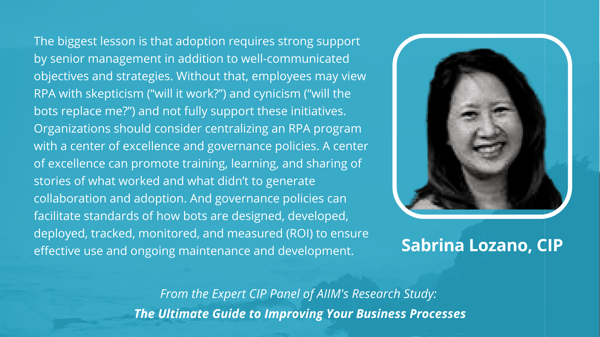
Experienced Users Share Their Best Tips for Process Automation
There are still many organizations that could benefit from the adoption of process automation technologies like Business Process Management (BPM), Robotic Process Automation (RPA), and Case Management. In fact, according to AIIM research, the overall adoption of these technologies is around 30-40% of organizations, skewed toward larger organizations with more than 1,000 employees. That leaves roughly 60-70% of organizations that make up potential users.
To help these potential users, we surveyed experienced users of BPM, RPA, and/or Case Management technologies for their best advice for getting started.
Here are 6 Pieces of Advice from Experienced Process Automation Users
1. Aim high – but not too high! – in setting the stage for your process automation initiative. Experienced organizations report significant benefits tied to VALUE – strategic alignment and transparency – as well as immediate cost savings.
In putting together their strategies and business cases, Potential users should note these key benefits recorded by experienced users –
- Cost Savings (18%) - Cost savings are necessary to justify process automation investments, but they represent table stakes in the larger value proposition centered around value and those looking to justify projects should make sure they do not focus on purely tactical and short-term benefits of process automation technologies.
- Increased Process Visibility and Measurement (18%) - Given the challenges that those inexperienced in process automation have in aligning resources with strategic change, the premium placed on process visibility and measurement is a key benefit that can be used by inexperienced users to help justify their projects.
- Better Allocation of Staff Resources (18%) - Likewise, given the change management concern about job loss cited earlier, potential users need to balance this concern with a key benefit realized by those who have already deployed these technologies – better allocation of staff resources.
2. Embed change management early on in your planning.
Perhaps reflecting past scars, even experienced users are very conscious of change management concerns and focus issues resulting from competing priorities when considering new projects. Those new to process automation are wise to recognize these issues and address them upfront and early in their project strategies.
3. Adopt the mindset that RPA, BPM, and Case Management are complementary technologies rather than replacements for each other.
4. Look to where experienced users have received significant benefit in selecting process targets. Financial processes are often a good place to start.
In thinking about where to start – always a key challenge for those new to these technologies – the process cited with the most significant projects are good places to mine for possibilities. Finance, accounts payable, and invoice processing is cited as a top three process across all three target technologies – BPM, RPA, and Case Management.
Finance is a useful place to start thinking about a process automation project for a number of reasons: 1) In leading organizations, Finance has moved beyond mere accounting to become a strategic function, critical in long-term planning; 2) Financial processes cut across and intersect just about every customer journey; 3) Making Finance an initial key Digital Transformation focus has great downstream benefits in expanding process automation to other departments.
5. Avoid single purpose SaaS approaches that can’t be scaled into other departments; this kind of an approach will often add to information chaos in the long-term.
Fear of customization – and all the complexity it entails when it comes time to upgrade – are major elements in driving organizations to cloud and SaaS solutions. SaaS solutions, though, need to be viewed through the prism of content services (i.e., an ability to surface content capabilities only when needed, and in context). Many inexperienced organizations initially attack process automation through a single purpose, single process SaaS solution, ultimately paying a price at a later date when they try to integrate across departmental processes in pursuit of better customer experiences.
6. Remember that RPA solutions are only effective to the extent that they can “digest” unstructured information.
Lastly, the two challenges identified by experienced users when implementing the newest process automation technology – RPA – are worth noting. Employees must be brought into an RPA implementation even earlier than with other process automation technologies in order to overcome employee resistance. The objective should be to position RPA as a “humans augmented by automation” proposition instead of one interpreted as “automation instead of humans.” Simplifying capture and making it available as a service is essential to the standardization of business inputs that is critical to optimizing the benefits of RPA.

Harness the Power of Experience
Albert Einstein said it best:
Information is not knowledge. The only source of knowledge is experience. You need experience to gain wisdom.
The next best thing to personal experience is to seek advice from those with experience. You've taken the first step here by reading through this post. As you continue on your automation journey, you'll likely be looking for more opportunities to ask for experienced advice.
Look to AIIM and its global community of information professionals - network and connect with others on the online discussion board, look for other Certified Information Professionals (CIPs) like the ones featured in this article, and look for professional development opportunities.






